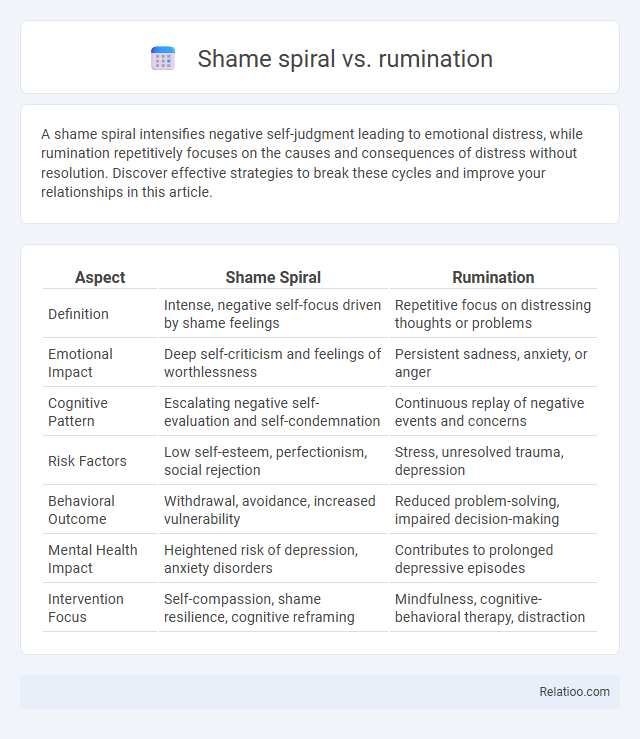A shame spiral intensifies negative self-judgment leading to emotional distress, while rumination repetitively focuses on the causes and consequences of distress without resolution. Discover effective strategies to break these cycles and improve your relationships in this article.
Table of Comparison
| Aspect | Shame Spiral | Rumination |
|---|---|---|
| Definition | Intense, negative self-focus driven by shame feelings | Repetitive focus on distressing thoughts or problems |
| Emotional Impact | Deep self-criticism and feelings of worthlessness | Persistent sadness, anxiety, or anger |
| Cognitive Pattern | Escalating negative self-evaluation and self-condemnation | Continuous replay of negative events and concerns |
| Risk Factors | Low self-esteem, perfectionism, social rejection | Stress, unresolved trauma, depression |
| Behavioral Outcome | Withdrawal, avoidance, increased vulnerability | Reduced problem-solving, impaired decision-making |
| Mental Health Impact | Heightened risk of depression, anxiety disorders | Contributes to prolonged depressive episodes |
| Intervention Focus | Self-compassion, shame resilience, cognitive reframing | Mindfulness, cognitive-behavioral therapy, distraction |
Understanding Shame Spiral: Definition and Dynamics
Understanding a shame spiral involves recognizing a vicious cycle where feelings of shame intensify through repeated negative self-evaluation, leading to emotional distress and withdrawal. Rumination, a key component of this process, entails persistent focus on perceived failures and flaws, exacerbating the spiral's intensity. You can break the cycle by identifying these patterns early and employing strategies to shift your mindset toward self-compassion and constructive reflection.
What is Rumination? Exploring the Cognitive Loop
Rumination is a persistent cognitive process where individuals repeatedly focus on negative thoughts, often exacerbating feelings of distress and hindering emotional recovery. Unlike a shame spiral, which centers on intense feelings of self-worthlessness triggered by a perceived failure, rumination involves a broader, cyclical analysis of problems without resolution. This cognitive loop traps the mind in negative thought patterns, increasing vulnerability to anxiety and depression.
Key Differences Between Shame Spiral and Rumination
Shame spirals involve intense feelings of self-worthlessness and negative self-judgment that escalate quickly, often leading to emotional paralysis or withdrawal, while rumination is a repetitive and passive focus on distressing thoughts without immediate emotional collapse. Your awareness of these key differences helps in identifying whether your mental focus is spiraling into shame or stuck in rumination, guiding you toward more effective coping strategies. Understanding that shame spirals are more emotionally charged and destructive than the cognitive loop of rumination is crucial for targeted mental health interventions.
Psychological Impact of Shame Spiral
Shame spirals involve a cyclical pattern of negative self-evaluation triggered by feelings of shame, which intensifies emotional distress and can lead to decreased self-esteem and social withdrawal. Unlike rumination, which is a repetitive focus on distressing thoughts or problems broadly, shame spirals center specifically on self-judgment and perceived personal flaws. The psychological impact of shame spirals includes heightened anxiety, depression, and impaired coping mechanisms, often exacerbating mental health challenges over time.
Mental Health Consequences of Rumination
Rumination involves persistent, repetitive thinking about distressing experiences or emotions, often intensifying symptoms of depression and anxiety. Unlike a shame spiral, which is characterized by escalating feelings of guilt and self-criticism, rumination traps individuals in a cycle of negative thought patterns that impair cognitive function and emotional regulation. Mental health consequences of rumination include increased risk of chronic stress, worsened mood disorders, and impaired problem-solving abilities, highlighting its role as a critical target for therapeutic intervention.
Triggers: What Initiates Shame Spiral vs Rumination?
Triggers for a shame spiral often include intense feelings of inadequacy or perceived personal failures that amplify self-criticism, whereas rumination is typically initiated by intrusive thoughts focusing on problems or past events without necessarily involving strong emotional pain. Your emotional response to these initial triggers determines whether you enter a shame spiral, characterized by overwhelming guilt and self-loathing, or a rumination cycle, where repetitive thinking leads to anxiety and stress. Understanding these distinct triggers helps in developing targeted coping strategies to interrupt these harmful thought patterns effectively.
Recognizing the Signs: Symptoms and Behaviors
Shame spirals manifest as intense feelings of worthlessness accompanied by self-critical thoughts, often leading to withdrawal and avoidance behaviors. Rumination involves repetitive and passive focus on negative emotions or events, characterized by persistent, cyclical thinking that impairs problem-solving and emotional regulation. Recognizing these symptoms--such as excessive guilt, persistent negative self-talk, and difficulty shifting attention away from distressing thoughts--helps differentiate shame spirals from general rumination patterns.
Breaking Free: Coping Strategies for Shame Spiral
Breaking free from a shame spiral involves recognizing and challenging negative self-beliefs that fuel persistent rumination, a repetitive focus on distressing thoughts or feelings. Effective coping strategies include practicing self-compassion, engaging in mindfulness techniques to disrupt automatic thoughts, and seeking social support to gain perspective and validation. Cognitive-behavioral approaches that reframe self-critical thoughts reduce the intensity of shame and help prevent the cycle of destructive rumination.
Effective Techniques to Manage Rumination
Effective techniques to manage rumination include mindfulness meditation, which helps you observe your thoughts without judgment, and cognitive-behavioral therapy (CBT) strategies that challenge negative thinking patterns. Engaging in physical activities and practicing self-compassion can reduce the intensity of shame spirals by shifting focus away from self-critical thoughts. Journaling your emotions allows you to process feelings constructively, breaking the cycle of repetitive rumination and fostering emotional resilience.
Building Resilience: Preventing Shame Spiral and Rumination
Building resilience involves recognizing early signs of rumination and shame spirals to interrupt negative thought patterns before they escalate. You can develop coping strategies such as mindfulness, cognitive reframing, and self-compassion exercises to reduce the intensity and duration of shame spirals and rumination. Strengthening emotional awareness and healthy self-talk supports mental well-being by preventing repetitive, harmful cycles of self-criticism and distress.

Infographic: Shame spiral vs Rumination
 relatioo.com
relatioo.com